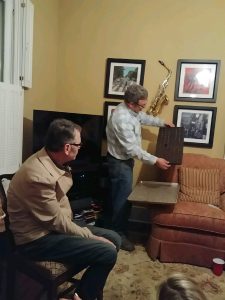by Dan Elgart

Our garden club meeting was packed with members to hear our newest member, Dan Elgart, talk about Plant Propagation,
His talk was so informative and extensive; we learned many new plant terms. We also appreciated his hands-on style of showing us exactly how to do each step. Dan was gracious enough to let us post his notes for future use. I’m sharing these in 2 parts. The first part is Planting Plugs or Seeds. Part 2 is Planting Liners or Cuttings. Thanks, Dan, for sharing your knowledge and joining our club.
Part 1-Plant Propagation Notes: Planting Plugs or Seeds
Most popular types of plant propagation methods:
- PLUGS-planting from SEEDS
- Cross-pollination–which yields seed-producing plants, and which we can take cuttings from these

- Vegetative reproduction–LINERS –rooting leaf sets or branch sections
- Hybridization thru grafting–producing non-seeding plants which require vegetative reproduction
PLUGS vs LINERS
- PLUGS–growing plants from seeds
- best for easy to grow plants, heirloom plants, hard to locate varieties
- LINERS–growing plants from cuttings
- use with plants whose seeds take forever to grow
- hybridized plants that can’t be grown from seed
Our zone 7 is a marginal zone: often too hot for more Northern Plants and too cold for more Southern Plants.
Use sites like Missouri Botanical Garden to find plants suitable for challenging sites.
QUICK LOOK AT SEEDS: break open a raw peanut, rub off the red skin, break open 2 sides of peanut. At the pit end of the peanut, we see a baby nib. This is the actual plant or zygote.
NOTE All seeds have a genetic trait or predisposition to germinate at a particular soil temperature when sufficient water is present.
The red skin covering the peanut contains a powerful enzyme that converts the starchy peanut into sugar or plant-soluble carbs or “Concentrated rocket fuel” which causes the plant to grow-grow-grow. This growing begins when the necessary soil temperature + sufficient water needs are reached.
As a side note: this is the basis of beer making. Brewers expose Barley, wheat, or rice seeds to a water bath set to an exact temperature. Within an hour, the seeds sprout. The Brewer is after the sugars removed from the grain’s starch. The sugars are rinsed off the sprouts, added to yeast and other goodies and magically turn into alcohol. Yum.
NOTE: Remember that temperature plays a major role in seed sprouting. This explains why we have spring weeds, summer weeds, and winter weeds. Different weed seeds germinate at different times.
STEPS FOR SUCCESSFUL SEED GROWING:
- Soak seeds overnight, then dry on paper towel. Helps quicken germination.
- Prep your PLUG TRAYS (containers).
- use new store-bought container, or better yet-
- go to local nurseries and get recycled containers from their boneyard (big pile of plastic containers)
- Add a few drops of bleach to a 5-gallon paint bucket of water and dip recycled containers in, then let air dry. Kills any possible plant germs
- Dan likes the 105 cell pack. You can buy these used from nurseries very inexpensively.
- Fill the PLUG TRAY (container) with soil mix. Dan likes to use peat soil mixes. You can use any seed growing soil mix. (These are sterilized to reduce fungus problems).
- (Many professional growers AVOID blends containing OAK OR HARDWOOD PARTICLES because of fungus concerns.),
- PINE BARK FINES (called soil conditioners) ARE PREFERRED because they have a higher PH and less likely to contain foreign pathogens.
- Pack the soil down, want to get rid of air pockets. Also, tighter soil encourages seed roots to work harder and become stronger.
- If the soil is bone dry, you should dampen it first. (This ensures that there will be no dry spots later when watering).
- Use wide pencil or chopsticks to poke a hole in the dirt
- Drop in 2 seeds
- (fold an index card in half, cut off top corner, drop seeds into index card and use the edge of a pencil to direct seeds into holes) Good tip, Dan!
- Label your seed container. Use pencil lead to label varieties as it won’t disappear when wet like sharpies, etc)
- Water your seed container from below, Use a large tray or sheet pan below your container and water until the soil is moist.
- (remember, “top watering” dry soil is likely to cause the upper surface of the soil to float and disturb your seed)
- Consider putting a heating pad under the flats for containers because warm soil means faster germination.
- (TIP: old water bed heaters are a cheap alternative to seed warmers).
- Can mount lights above plugs.
- Dan suggests mounting your lights on small chains that can be hooked on a nail or “S-hook” so you can raise or lower the lamp as needed.
- Use a weak solution of plant food in your watering solution.
- It can take 3 weeks or more for some plants to germinate. Don’t get discouraged.
- You want your plugs a bit rootbound before re-planting in bigger pots or your garden. This will help support the young plant and prevent them from falling over after replanting.
HAPPY PLANTING PLUGS!
PART 2: PLANTING CUTTINGS IN LINERS coming soon.